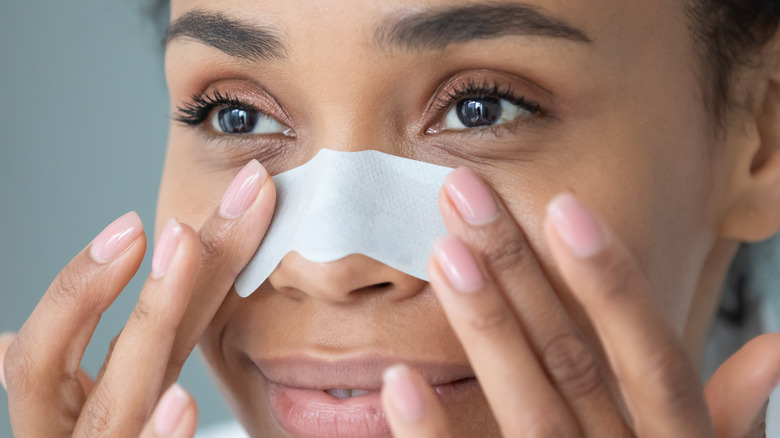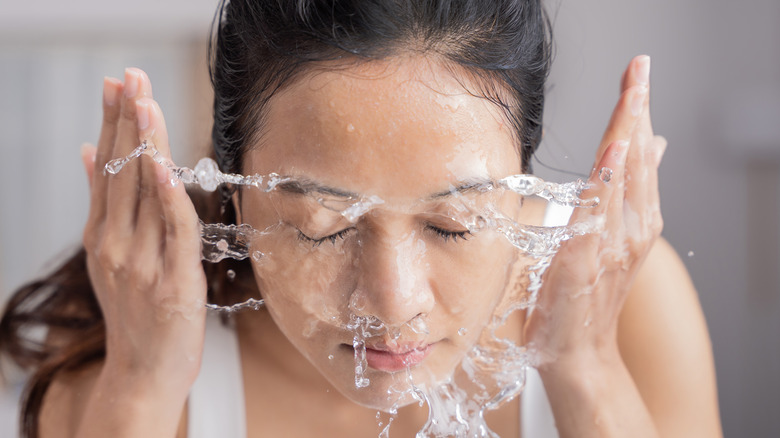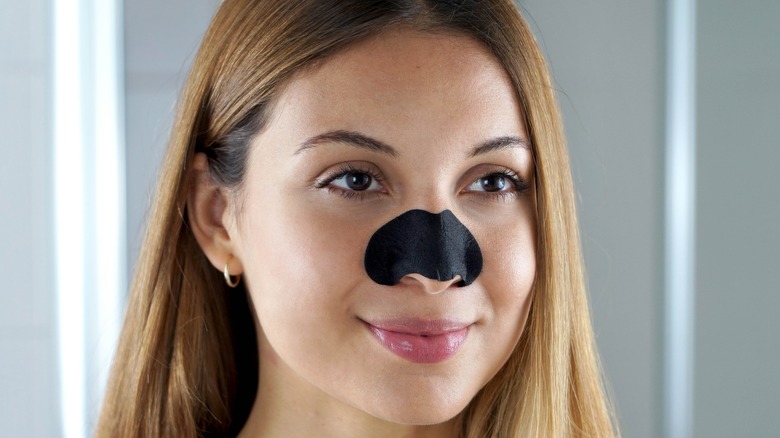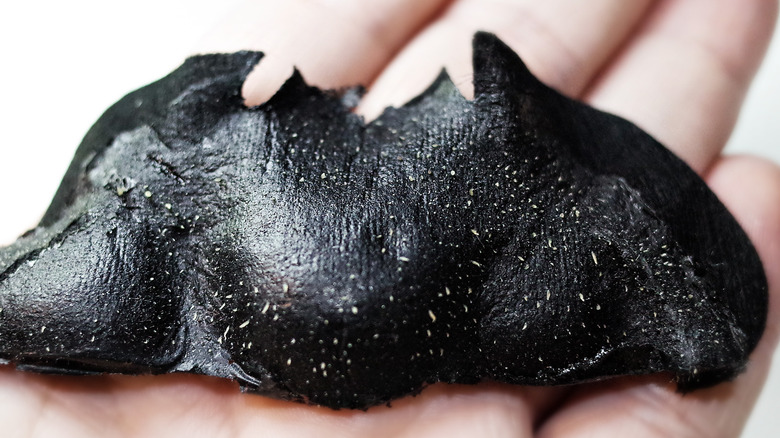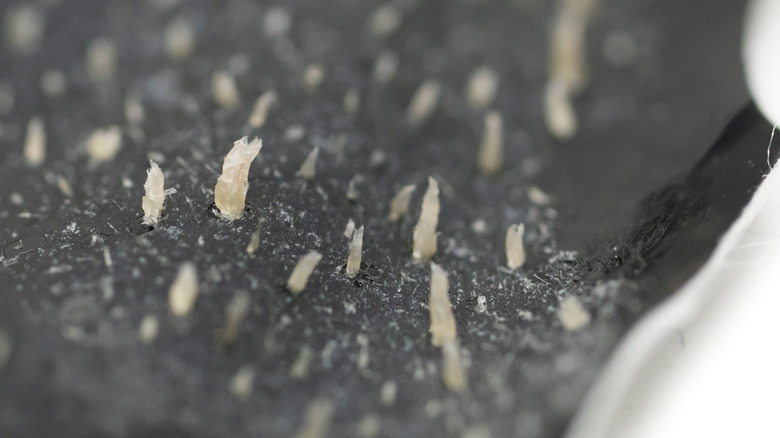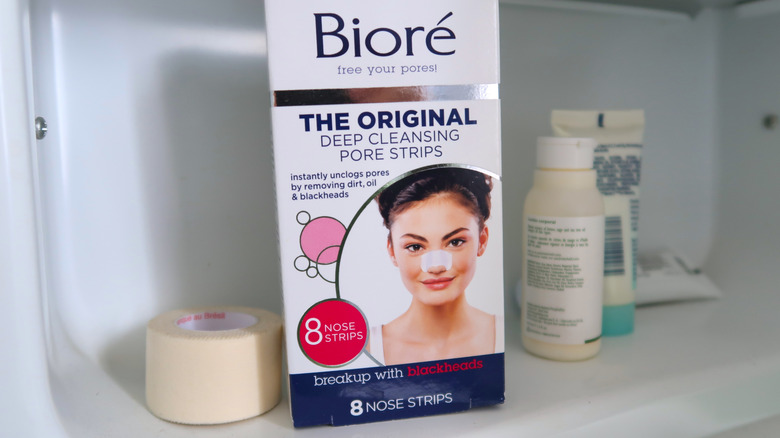What's Really Happening When You Use A Pore Strip?
By 2027, the global pore strip market will be worth a whopping $2 billion, per ReportLinker. However, this comes as no surprise. Use of this famous beauty item has soared in recent years, with videos of customers trying pore strips racking up thousands of views online among spot lovers. Often, these videos show the gunk-filled result that sits on the strip — the one that many consumers find ever so satisfying. While seeing the end result is one of the main reasons many people love this product, pore strips also tout other beneficial qualities that help get them flying off the shelves, such as ease of use and speed. This nifty product is a great way to keep their pores in check for many.
However, while it is easy to slap them on your face and let them work their magic, you may still be unaware of how a pore strip actually works. Once you discover what happens, you may think twice before incorporating them into your beloved beauty routine. So, what's really brewing underneath the surface of that pore-hungry strip?
Water activates the pore strips
The typical first step when you apply a pore strip is to gently wet your nose with warm water. After this, it's incredibly easy to whack it on without thinking about how it works. However, there are some fascinating reactions going on down under your much-loved strip. Once the water is applied to the nose and comes into contact with the pore strip, the opposite charges of the water and your pores attract one another. This process "allows the polymers to bond to plugged pores," explains group leader of R&D Skincare Group, Erika Palmer, to Self. Thanks to this technology, you can rip the gunk out of your pores and still see it firmly attached to your strip.
As you may have already gathered, this step is a vital part of the process. If you don't wet your nose, then you run the risk of your pore strip not working at all, as the adhesive will not be able to stick properly. Not only will this waste your time, but it will also waste your money.
The adhesive helps the strip stick
In addition to the water, the lining of adhesive on the underside of your pore strip helps to keep it firmly in place so that it can get down to work in your pores. The adhesive is usually activated by the water, with the pair working in harmony to help stick to all the gunk and dirt in your pores.
However, while the adhesive allows for firm placement on your skin, it does have its downsides. Speaking to Shape, board-certified dermatologist Robert Anolik M.D. explains that the adhesive in pore strips also "removes the hydrating oils from your skin." In turn, "your skin produces more oil" as a result, which can end up aggravating the problem even more as excess will build up. This build-up can end up clogging your pores, which can lead to more blackheads and breakouts — exactly what you don't want. It's for this exact reason that it's best to use your strips sparingly. By doing so, you will help to prevent any unnecessary clogging.
Pore strips help to remove excess dirt and oil
So, what happens when a pore strip is on your skin? Once placed firmly down, it gets to work targeting your blackheads, which you can commonly find on your nose and chin. Blackheads are open pores clogged with excess oil and dirt, identifiable through their black color. Both the adhesive and water mix help to remove any extra buildup of these two components. As mentioned earlier, they extract the oil and dirt using positive and negative charges.
The whole process usually takes around 15 minutes and usually ends with all the gunk being ripped out of your nose. Pores once filled with excess oil and dead skin should no longer appear black. In its place should be smoother, clearer-looking skin. However, it is essential to note that pore strips only work to target blackheads and not other types of acne. Some people even use pore vacuums to clear blackheads, although the devices can come with some unwanted side effects.
Pore strips only treat your skin at surface level
While many individuals cherish and love pore strips, they may not help solve your blackhead woes in the long term. According to cosmetic chemist Ginger King, the strips don't actually get to the root of the problem, as they only remove what is on the surface rather than what lies deeper in your pores (via Self). To maintain the look of having blackhead-free skin, you may have to use pore strips up to two times per week, explains dermatologist Shari Marchbein from New York (via Allure). These temporary results will therefore require lots of upkeep to stay maintained — and even then, it's not treating the root of the problem, quite literally.
So, although they are satisfying to use, pore strips could cost you a pretty penny in the long run. Instead, there are some ways you can prevent blackheads from forming, which is always an excellent option if you're looking for a long-term solution.
They can irritate certain skin types
While pore strips are generally safe, some people can experience slight irritation as a result of using them, such as individuals with dry or sensitive skin (via Real Simple). Likewise, those who suffer from rosacea, a skin condition that causes visibly flushed and red cheeks, should also be cautious when using pore strips. Board-certified dermatologist Azadeh Shirazi, M.D. recommends that those with the condition should be careful not to overuse this pore-zapping product, as it could potentially aggravate symptoms and damage your skin barrier.
Skin irritation from using pore strips is often a result of your skin reacting to the adhesive. This irritation usually occurs once you have applied the product to your skin. While they may seem innocent enough, plenty of reactions are still bubbling away underneath that pore strip. So, although blackheads may be frustrating, it is best to refrain from using the strips if you find yourself having a reaction as a result of using them. However, if you experience no irritation, you should be good to go — but be careful not to overdo it!
